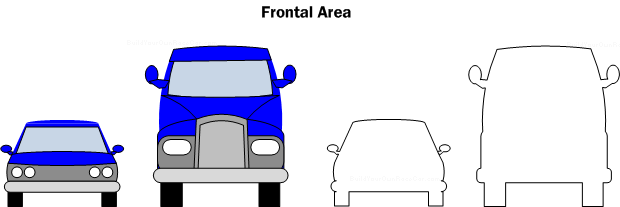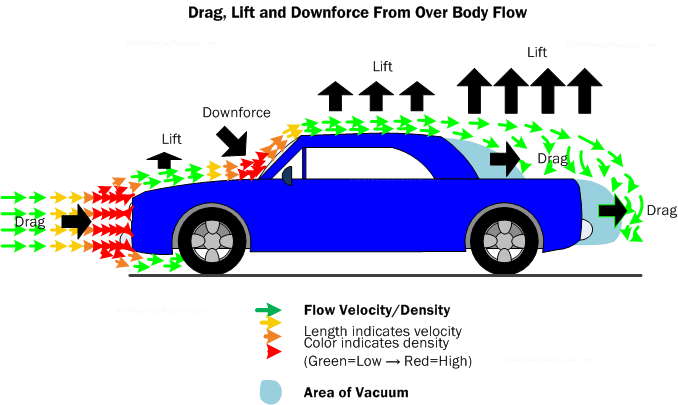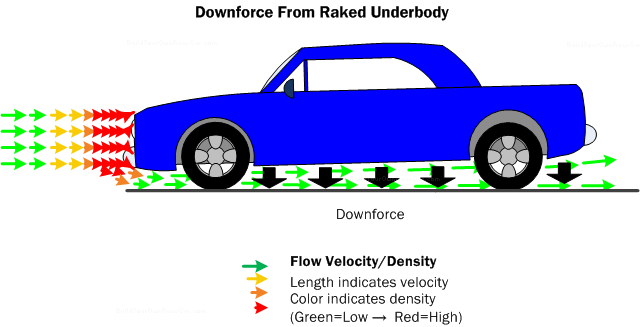Car Aerodynamics Basics and How-To Design Tips cont…
Aerodynamic Principles cont…
Frontal Area
Drag coefficient, by itself is only useful in determining how “Slippery” a vehicle is. To understand the full aerodynamic effect of a vehicle’s body shape, we need to take into account the frontal area of the vehicle. The frontal area defines the size of the hole the vehicle makes in the air as it drives through it.
In diagram FA1 below, the sedan car makes a far smaller hole in the air than the semi-trailer tractor.

Diagram FA1. Frontal areas of a car and large truck. Minimizing frontal area in car design is important and easier than reducing the Cd which is almost always more difficult.
So then it is by combining the Cd with the Frontal area that we arrive at the actual amount of drag created by a vehicle.
Lift/Downforce
Downforce is the same force as the lift experienced by airplane wings, only it acts to press down instead of lifting up. Every object travelling through air creates either a lifting or downforce situation. Most race cars and some road cars use aerodynamic devices such as inverted wings to force the car down onto the road, increasing traction. The average street car however tends to create lift. This is because the car body shape generates a low pressure area above itself.
According to Bernoulli’s principle, for a given volume of air, the higher the velocity the air molecules are travelling, the lower the pressure becomes. Likewise, for a given volume of air, the lower the velocity of the air molecules, the higher the pressure becomes. This applies to air in motion across a still body, or to a vehicle in motion, moving through relatively still air.
In the Frontal Pressure section above, we said that the air pressure was high as the air rammed into the front grill of the car. What is happening is that the air slows down as it approaches the front of the car, and as a result more molecules are packed into a smaller space. Once the air stagnates at the point in front of the car, it seeks a lower pressure area, such as the sides, top and bottom of the car.
Diagram LD1 below demonstrates this effect using arrows to indicate the air velocity and density.

Diagram LD1. Drag, lift and downforce from over body flow. The body shape creates lift and downforce from the air flow. Drag is cumulative as the air flows from the front to the rear of the vehicle.
As the air flows over the hood of the car, it’s loses pressure, but when it reaches the windscreen, it again comes up against a barrier, and briefly reaches a higher pressure. The lower pressure area above the hood of the car creates a small lifting force that acts upon the area of the hood (Sort of like trying to suck the hood off the car). The higher pressure area in front of the windscreen creates downforce. This is akin to pressing down on the windshield.
Where most road cars get into trouble is the fact that there is a large surface area on top of the car’s roof. As the higher pressure air in front of the wind screen travels over the windscreen, it accelerates, causing the pressure to drop. This lower pressure literally lifts on the car’s roof as the air passes over it.
Worse still, once the air makes its way to the rear window, the notch created by the window dropping down to the trunk creates a vacuum (or low pressure space) that the air is not able to fill properly. The flow is said to detach and the resulting lower pressure creates lift that then acts upon the surface area of the trunk. Prior to the use of aerodynamic devices to reduce these effects, race car drivers would feel the car becoming “light” in the rear when travelling at high speeds.
Not to be forgotten, the underside of the car is also responsible for creating lift or downforce. If a car’s front end is lower than the rear end, then the front end restricts the air flow under the car and the widening gap between the underside and the road creates a low pressure area. If there is neutral or higher air pressure above the car, then we get downforce due to the difference in the pressure above and below the car. See the diagram LD2 below:

Diagram LD2. Downforce from raked underbody. The widening gap between the underside of the car and the road lowers the air pressure underneath.
So, as you can see, the airflow over a car is filled with high and low pressure areas, the sum of which indicate that the car body either naturally creates lift or downforce.
Aerodynamics How-To Tips (2/4)
Use Spoilers
Spoilers are widely used on sedan type cars such as NASCAR stock cars. These aerodynamic aids produce downforce by creating a “dam” at the rear lip of the trunk, raising the air pressure over the trunk. Where a notch left by the rear window exists a spoiler can help restore pressure to the void behind the window.
Use Wings
Wings are the inverted version of what you find on aircraft. They work very efficiently, and in less aggressive forms generate more downforce than drag, so they are loved in many racing circles and by high performance road car builders. Wings are best placed in areas that have clear airflow to them. Placing a wing behind an obstruction reduces the downforce the wing can produce.
Use Front Air Dams
Air dams at the front of the car restrict the flow of air reaching the underside of the car. This creates a lower pressure area under the car, effectively providing downforce. In many cases, the air dam also reduces the Cd of the vehicle.
49 2 40 7


